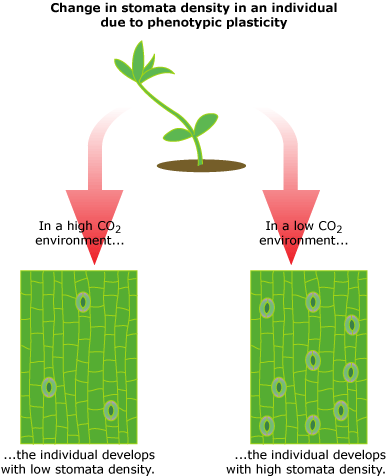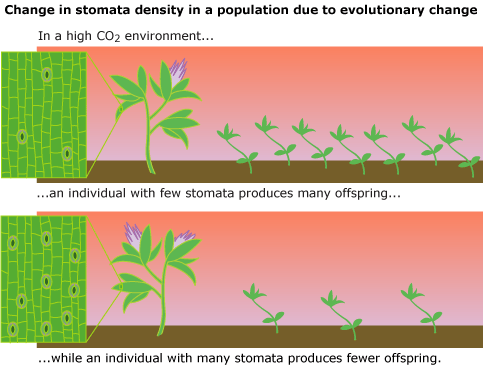 Jennifer studies change in the stomata on leaves over time — but is this evolutionary change — in other words, descent with modification? The answer is surprisingly complex.
Jennifer studies change in the stomata on leaves over time — but is this evolutionary change — in other words, descent with modification? The answer is surprisingly complex.
For example, if you take a mustard plant seedling and move it to an environment with high carbon dioxide levels, the new leaves grown in that environment will have fewer stomata. Is this change in stomata an example of evolution at work? Clearly, the answer is no. In this situation, there is no change in the genetic makeup of the plant or its population which could be passed on to the next generation. The ability to pass changes from one generation to the next is a defining characteristic of evolution. This non-heritable change in the mustard seedling is called phenotypic plasticity, meaning that the organism’s phenotype is flexible and can be influenced by the environment. We are familiar with phenotypic plasticity from human populations. The average human alive today is taller than the average human alive 100 years ago — but this change is not the result of evolution. Instead, it is probably mainly the result of diet; human diet is, on average, better today than it was 100 years ago, causing humans to grow taller.
However, over longer time scales (e.g., thousands or millions of years), the genes involved in determining number of stomata can accumulate mutations and change in frequency. Those changes can be passed from generation to generation and represent evolutionary change. For example, as humans release greenhouse gasses into the atmosphere, we increase carbon dioxide levels worldwide. In this high-carbon-dioxide environment, plants with genes that cause them to produce fewer stomata will have an advantage over other plants since they will be better able to conserve water, while still getting enough carbon dioxide. Those few-stomata plants will survive better, reproduce more, and pass their genes for few stomata on to their offspring. Through this process of evolution by natural selection, plant populations with fewer stomata will evolve over many generations.

So do the changes that Jennifer observes in plant stomata represent phenotypic plasticity or evolutionary change? Well, it depends. In experiments with modern plants over short time scales, Jennifer is observing phenotypic plasticity. But in studies of fossil plants in which change occurs over thousands or millions of years, that change is likely evolutionary in nature. However, regardless of whether changes in number of stomata are genetic or phenotypic, they are still indicative of changes in carbon dioxide level.
Learn more about the process of natural selection.
